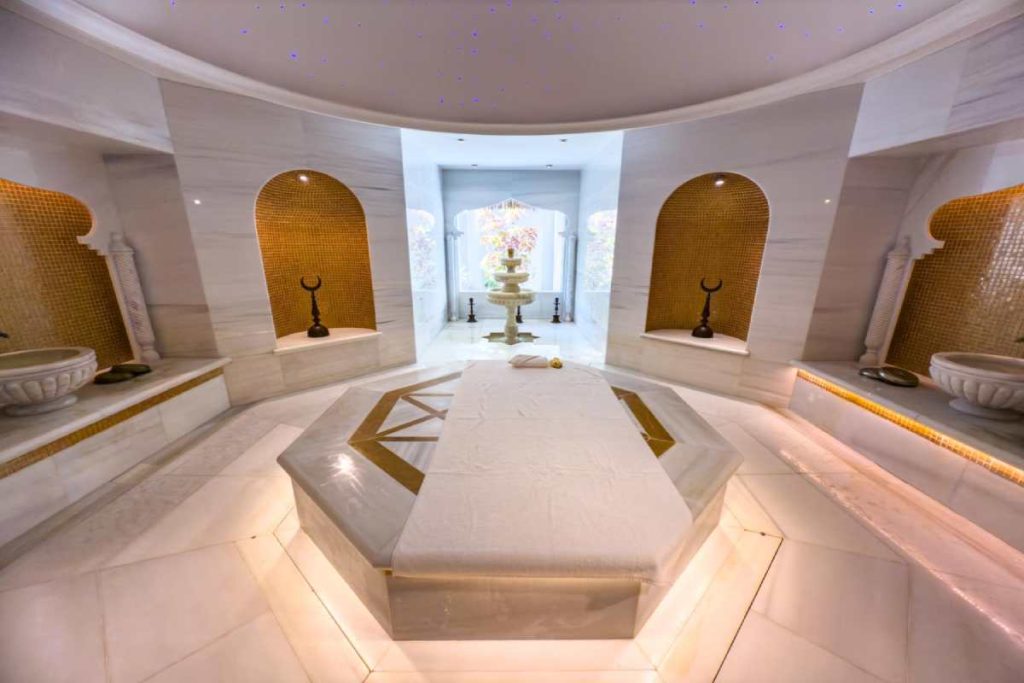Understanding the Origins of the Hammam
The Hammam traces its roots to Roman thermae and later evolved in Islamic and Ottoman cultures. A Hammam is not just a place for bathing—it’s a cultural ritual centered on purification, relaxation, and social connection. Its structure and experience are distinct from the sauna, which has Nordic origins and was developed for solitary or family-based steam sessions.
Temperature and Humidity Levels in the Hammam
One of the main differences between a Hammam and a sauna is the environment. A Hammam typically maintains lower heat (around 40–50°C) but with very high humidity. In contrast, saunas operate at much higher temperatures (70–100°C) with low humidity, creating a dry heat that affects the body differently. This makes the Hammam gentler on the respiratory system and more accessible to first-timers.
The Ritual Structure of the Hammam
The experience of a Hammam is ritualistic and multi-staged. A Hammam session typically includes time in a warm steam room, followed by a full-body exfoliation, a luxurious foam massage, and a rinse. Saunas, by contrast, are often self-directed: users alternate between dry heat exposure and cold showers. The guided and hands-on approach of the Hammam offers a more immersive wellness experience.
Skin and Circulation Benefits of the Hammam
Thanks to its unique exfoliating process, the Hammam promotes clearer, smoother skin. In a Hammam, dead skin cells are scrubbed away using a kese mitt, allowing the skin to breathe and absorb moisture more effectively. While saunas also enhance circulation and open pores, they do not involve the same direct skin treatment as a Hammam.
Relaxation and Emotional Wellness in the Hammam
The serene atmosphere of a Hammam encourages not only physical cleansing but also emotional healing. The combination of steam, massage, and silence in a Hammam leads to mental clarity and emotional calm. Saunas also offer stress relief, but the tactile rituals and structured care found in a Hammam add a deeper layer of mindfulness and self-connection.
Social and Cultural Significance of the Hammam
A Hammam has historically served as a communal gathering place, especially in Middle Eastern and North African cultures. Visiting a Hammam was a social event—shared among friends, family, or even strangers. Saunas, especially in Nordic countries, may be shared but are usually more intimate or private. The communal and cultural essence of a Hammam offers a unique sense of tradition and togetherness.
Conclusion
While both the Hammam and sauna provide excellent health and relaxation benefits, their experiences are fundamentally different. The Hammam offers a structured, high-humidity ritual involving exfoliation, massage, and deep cleansing. Saunas provide a dry, high-heat experience geared toward simplicity and muscle recovery. Whether you seek cultural immersion, glowing skin, or quiet contemplation, the Hammam offers a holistic journey rooted in ancient wellness wisdom.
Frequently Asked Questions
- Is the Hammam hotter than a sauna?
No, a Hammam has lower heat but higher humidity compared to a sauna. - Do I need to bring anything to a Hammam?
A Hammam usually provides essentials, but you can bring your own toiletries and flip-flops. - Is the Hammam safe for people with asthma?
Yes, the high humidity of a Hammam can be gentler on the lungs than a dry sauna. - Do men and women share the same Hammam space?
Most Hammam spas have separate areas or time slots for each gender. - Can I go to a Hammam if I have sensitive skin?
Yes, but let your therapist know so they can use a softer scrub during the Hammam session. - Is the Hammam experience painful?
No, a Hammam treatment may feel firm but should never be painful—always communicate your comfort level. - How long does a typical Hammam session last?
A full Hammam experience lasts about 60 to 90 minutes depending on services included. - Are saunas or Hammams better for weight loss?
Both may promote sweating, but the Hammam adds exfoliation and muscle relaxation benefits. - Can I combine a Hammam with other spa treatments?
Yes, many spas offer packages combining the Hammam with facials or massages for a full-body experience. - Do I need to tip at a Hammam?
Yes, tipping is customary after receiving services at a Hammam.
